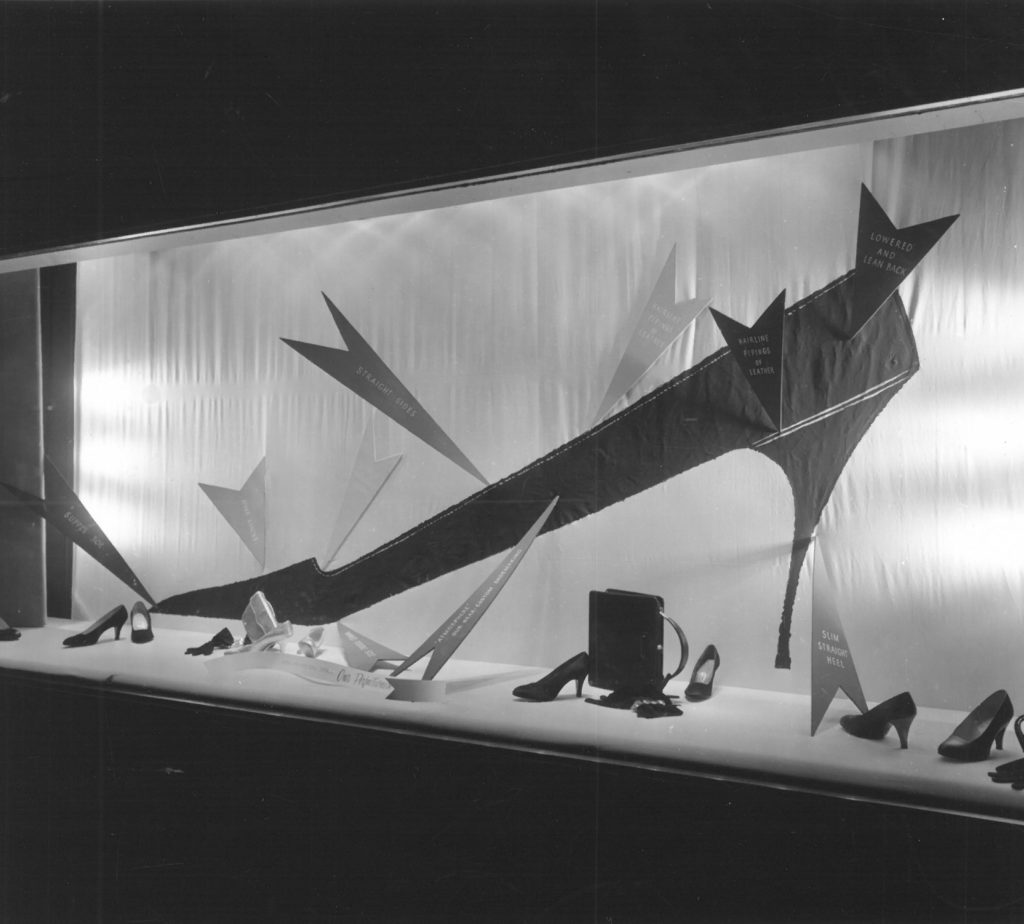Opinion
A Collaboration Made in Heaven: Andy Warhol, Jasper Johns, Robert Rauschenberg
THE DAILY PIC: In 1955, a window display deployed the talents of three greats of postwar art.

THE DAILY PIC: In 1955, a window display deployed the talents of three greats of postwar art.

by
Blake Gopnik

THE DAILY PIC (#1637): It’s an art-world dream team: Andy Warhol, Jasper Johns and Robert Rauschenberg, collaborating on a single installation. Unfortunately, the team-up didn’t yield anything more stunning than today’s Daily Pic, which shows a relatively pedestrian window at the I. Miller shoe store in Manhattan on August 4, 1955.
Thanks to the stylish newspaper ads Warhol had just begun producing for I. Miller, Warhol was winning a reputation among insiders as New York’s go-to guy for shoe imagery. (It was hardly public “fame,” as has often been claimed.) For their part, Johns and especially Rauschenberg were starting to be known in the world of cutting-edge fine art, even as they earned a living supplying props and backdrops for window displays under the shared pseudonym of Matson Jones. One day in the 1950s, as Johns told the interviewer Paul Taylor, “Bob Rauschenberg and I were working together, and one of the jobs that we had gotten was to interpret some of Andy’s shoe drawings in a kind of three-dimensional window display.” The result was almost certainly the window in today’s Pic. (Johns recently told me that Warhol later claimed he wasn’t aware of the project – which seems unlikely, given his eagle-eyed attention to his own reputation.)
A couple of things to point out about the 1955 “collaboration.” First, contrary to what’s often said, in the 1950s there wasn’t much reason for any of these artists to feel ashamed of working in display. The Bauhaus desire to collapse fine and commercial art still had some force (it played a big role in Warhol’s education), and department stores and their display managers, as well as their customers, were keen on melding fine art and retailing. When it wasn’t mounting actual art exhibitions, Bonwit Teller, the department store where Warhol and “Matson Jones” did a lot of their window work, had one week a year when all its streetside vitrines were turned over to signed fine art by the freelance artists who had worked on their displays. In a single week in 1957, Bonwit’s windows featured fine art by our three heroes, before it had been seen much of anywhere else. Johns showed one of his pioneering Flags, Rauschenberg showed a very early Combine and Warhol put up unassuming 1950s drawings, but followed four years later at Bonwit’s by full-blown Pop paintings. (Although it’s not certain that Warhol showed in the same week as the other two, I have a feeling the invidious comparison in 1957 helped spur Warhol to up his game.) At any rate, if any of the three had had doubts about the status of window displays, they’d hardly have helped launch their careers by showing in them.
Retail windows by all three of these artists appear side-by-side in an article in a 1961 issue of Graphis, the great Swiss design magazine, and all three of them use their real names in the captions. Despite the very public venue for the photos – or because of it – Matson Jones is nowhere to be seen.
This leads to the second take-home from today’s Pic. Early contact between Warhol and his two colleagues helps undermine the now-standard story about how Johns and Rauschenberg, a couple who were mostly closeted or at least ultra-discreet, had contempt for Warhol’s “swish” and openly gay manner. Two different straight friends of Warhol’s are supposed to have told him about that contempt, but they may very well have been imagining it or trying to stir up trouble. Jasper Johns told me that he never harbored any anti-Warhol feelings, let alone homophobic ones: “I was fond of Andy and have no memory of ever ‘cutting him dead,’ ” which is how the story gets told. There’s actually plenty of evidence of mutual respect and even fondness between him and Warhol: Outings with Johns show up any number of times in Warhol’s early-’60s datebooks, and as Johns emphasizes the two men were eager owners of each other’s best art.
Anyway, Warhol was hardly the only visibly homosexual figure on New York’s cultural scene: It was one of the few settings in the country where you could afford to come off as gay, and lots of people took advantage of that. Cecil Beaton and Ned Rorem hardly hid behind a girl-crazy façade, and I don’t suppose Johns had time to cut them and all of their friends.
My favorite evidence of the Warhol-Johns friendship is a lovely early-’70s Polaroid that was sold at Christie’s in 2012. It shows Warhol, the man said to be terrified of physical contact, looking beatific in the act of hugging Johns; Johns, the man always said to be aloof and reserved, pats his friend’s hand and looks tickled pink to be receiving the embrace.
For a full survey of past Daily Pics visit blakegopnik.com/archive.